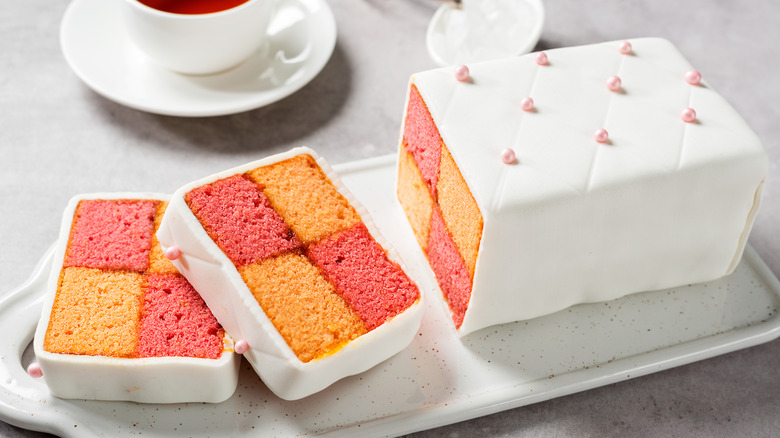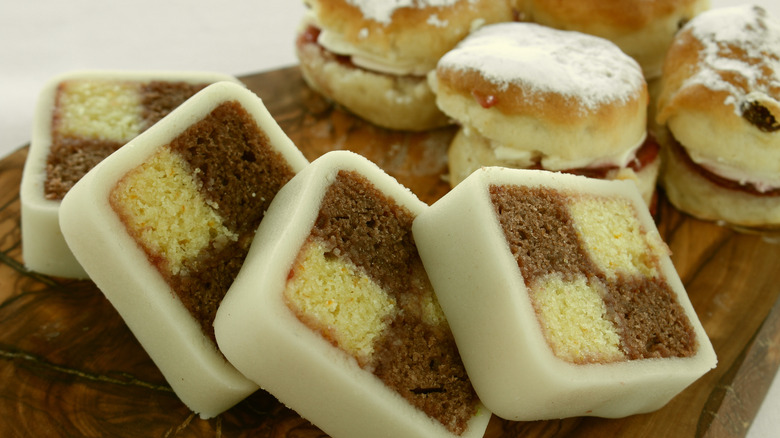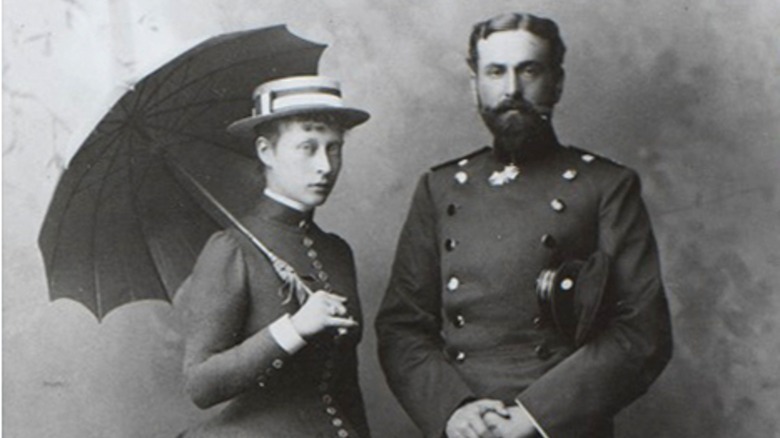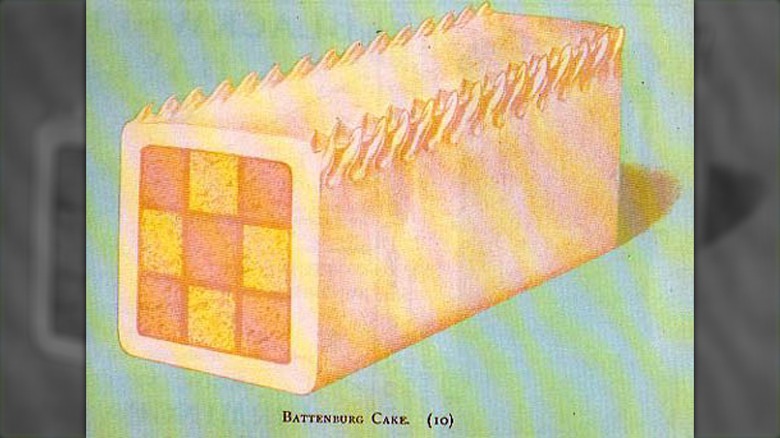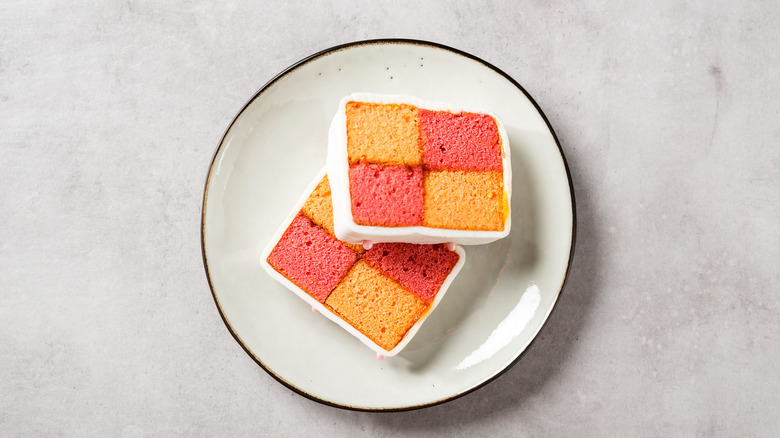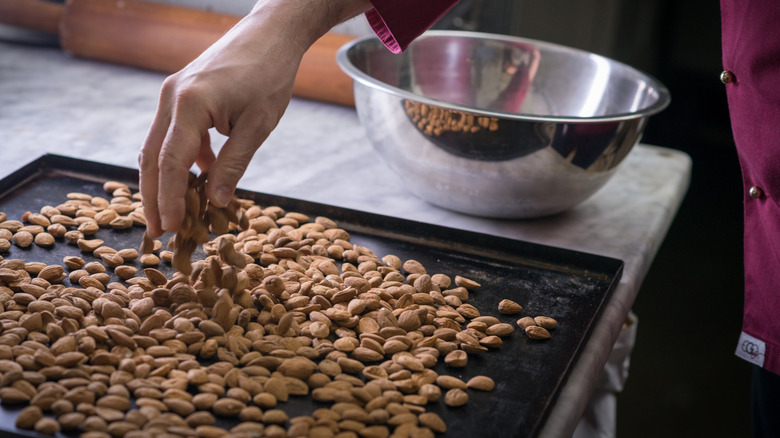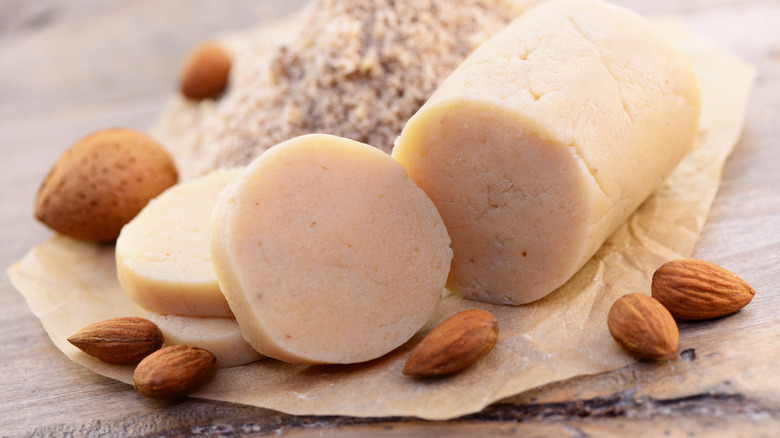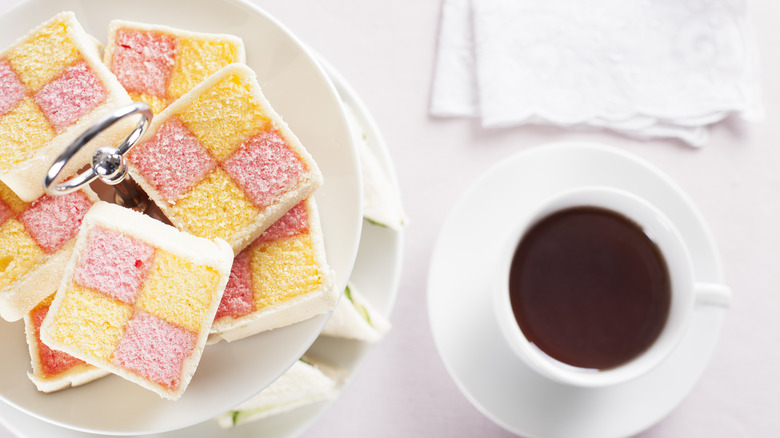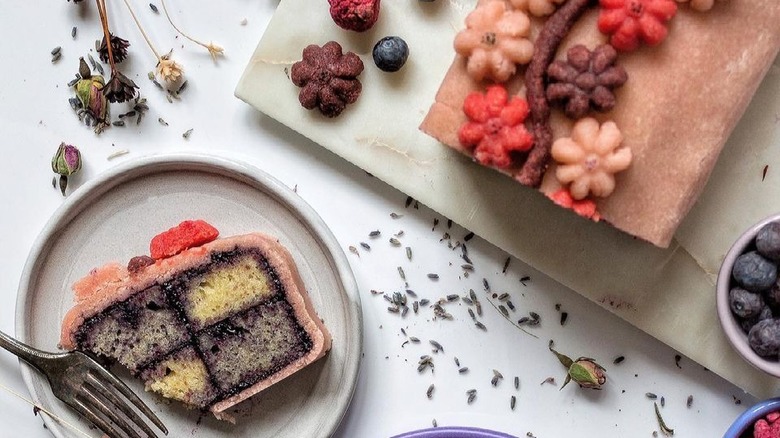A Beginner's Guide To The British Classic Battenberg Cake
We may receive a commission on purchases made from links.
If you've ever binge-watched a season of "The Great British Bake-Off" or attended a traditional English tea, then you've likely been introduced to an eye-catching traditional British confection known as the Battenberg cake. With a history spanning over a century, this delightful little teatime treat has entrenched itself in British culture with its colorful checkerboard pattern. Bakers and diners alike can't get enough of the delicate almond sponge and smooth marzipan exterior.
But there's more to this deceptively simple cake than meets the eye. For one thing, what is often thought of as a purely Victorian dessert actually has a much longer history. And that famous four-square checkerboard pattern — would it surprise you to learn that Batternberg cakes didn't always look that way? There's so much to explore when it comes to this fascinating treat and how it came to be in the first place. Keep reading to learn all there is to know about the iconic Battenberg cake!
So what exactly is a Battenberg cake?
Sure, you might have heard of a Battenberg cake before or seen pictures of it, but if you're not from the UK, you might never have tried or seen one in person. So what exactly is a Battenberg cake, and what makes it so unique?
Simply put, a Battenberg cake is a small rectangular loaf made up of four, nine, or more long strips of sponge cake (usually Genoise sponge). Those strips of cake are stuck together using jam, spread, or icing, and then the whole thing is topped off with a layer of marzipan, which is essentially a sweet almond paste used for dessert making. Some modern bakers may also use fondant to cover the cake, but that's not traditional.
The Battenberg cake has seen some major image shifts in its lifetime. What began as a luxury cake served to 19th-century royals became a middle-class teatime treat and was eventually mass-produced into mini cake bars that you can eat on the go.
The Battenberg cake's origin story has royal roots
There's a lot of myth and legend surrounding the Battenberg cake, tracing back to the 19th century and the royal family of England. It got its name from the Battenberg family, a German noble family with close ties to the British royals. In 1884, Princess Victoria Hesse, a granddaughter of Queen Victoria, married Prince Louis of Battenberg, a German prince. The cake is said to have been invented to celebrate the union, although there is no material evidence that it was served at the celebration. The first known recipe for this cake appeared in "Cassel's Dictionary of Cookery" in 1883. The cake's unique checkered pattern, which alternates between pink and yellow squares, is said to symbolize the four Battenberg princes, at least according to the myth.
It's unlikely that the cake was created for the first time in honor of the wedding, but the Battenberg name stuck, and it has forever been linked to the English royal family from then on. Interestingly, the Battenberg cake has kept its name over the years, even when its namesake did not. During World War I, when anti-German sentiment was at its height, King George V proclaimed that the royal family would change its name from Saxe-Coburg and Gotha to Windsor. His cousin, Prince Louis, joined suit and restyled himself from Battenberg to Mountbatten, an anglicized version of the name.
The original Battenberg cake had nine (or more) squares
When we think of a Battenberg cake, generally the image that comes to mind is that of a simple four-square design. No wonder another popular name for this cake was the "church window cake," since the four squares resembled a simple window frame. But while the Battenberg cake that we're all familiar with today almost always has just four squares, the oldest examples of this cake that we know of more often had three rows of three, for a total of nine squares. This debunks the myth that the four squares were meant to represent the four Battenberg princes.
How do we know that the Battenberg cake originally had nine squares? Just 14 years after the famous royal wedding that supposedly inspired this cake, we see recipes appear in cookbooks like Mrs. Agnes Berthe Marshall's "The Table," published in 1898, featuring illustrations of nine squares rather than four. Just about every cookbook illustration of the early 20th century features this cake in its nine-square version instead.
As time went on and this cake became more popular, bakers attempted to create more elaborate versions. In fact, by the 1930s, we can see examples of some bakers testing out their technical skills by creating Battenburg cakes with around 25 squares!
It's as uniquely beautiful as it is delicious
The hallmark of the Battenberg cake is its precise checkered pattern. The alternating vibrant pink and pale yellow squares create a stunning visual contrast. This pattern is not only visually striking but also requires meticulous assembly, reflecting the cake's attention to detail and craftsmanship.
There's also the matter of colors. Why is a traditional Battenberg cake pink and yellow? Even in the modern day, these two colors are the iconic pair that defines the Battenberg design. While we don't know exactly why the squares are traditionally pink and yellow, the prevailing story is that the pink signifies Princess Victoria's family, the house of Saxe-Cobourg-Gota, while the yellow is supposed to represent Prince Louis' Battenberg ancestry.
The exterior of the cake is deceptively simple: a thin sheet of marzipan is draped over the top to give the cake a smooth fondant-like look to it. You'll often see the marzipan scored with a quilted or stitched pattern to provide it with a little bit of visual interest. You might even see some piping or sprinkles to add a touch of color, but usually, the decorations are minimal. This adds to the "wow" factor when the cake is first cut, exposing the vibrant colors.
Traditional Battenbergs are all about the almonds
Originally native to the Middle East, almonds have been harvested for food for thousands of years. They were grown in the Mediterranean by the seventh century, but they weren't grown in England until about the 16th century. And while they were more accessible by the 19th century, they were still considered quite a high-status item by the time the Battenberg cake was created. So when Victoria and Louis were married in the 1880s, an almond-forward cake like the Battenberg would have been the perfect item to serve at a royal celebration.
Almond flavor permeates through every part of the Battenberg cake. For one, the Genoise sponge that makes up the body of the cake is often flavored with almond extract, especially in the yellow squares, which helps give a subtle nuttiness to the sponge cake's sweetness. While the other colored squares can have other flavors, like vanilla, for example, this isn't always the case. On top of the almond flavoring on the inside, the marzipan coating creates a delightful almond flavor on the outside.
The not-so-secret ingredient is marzipan
While marzipan plays a crucial role in the Battenberg cake's overall flavor and texture, the choice to include it in the original recipe was intentional. Marzipan has been a popular confection in Europe since the Middle Ages, but Germany is especially attached to it. In fact, Lübeck, Germany claims to have invented modern-day marzipan, at least according to local legend. So it's only natural that it was included in a cake meant to celebrate a marriage involving a German prince.
Marzipan is essentially a moldable paste with a texture similar to modeling clay that is made from crushed almonds, egg whites, and sugar. It doesn't require cooking to eat, so it's often molded into fun novelty shapes, painted with edible food coloring, and eaten raw. It should be noted that marzipan isn't the same as almond paste, since the added sugar and egg give it a smoother, more workable texture.
Marzipan plays a very special role when it comes to Battenberg cakes. The layer of marzipan that envelops the cake provides a protective barrier, sealing in moisture and enhancing the cake's shelf life. Marzipan also offers a slightly chewy texture to contrast the softness of the sponge cake.
Assembling the checkerboard pattern takes some serious technique
The classic Battenberg cake is satisfying to look at because of its clean, straight lines and symmetrical form. Creating the iconic Battenberg pattern may seem rather simple on the surface, but it actually requires a lot of precision to get the look right. Just the slightest miscalculation when cutting the cake pieces or laying on the fondant could spell disaster and lead to an uneven, lumpy, or misshapen cake. Here's how to create one for yourself:
The process starts with two sheet cakes in different colors, usually pink and white. The sponges are measured and cut into long rectangles of equal height and width so that when they're arranged together, they create a checkerboard pattern. The sponges are attached together by spreading a layer of jam between each layer. Finally, a sheet of marzipan is rolled out in a thin, even layer and wrapped around the sponges on all sides to ensure a neat finish.
Sure, modern-day cakes might be a little more involved and technical than this classic recipe. But it was a major culinary feat in its day. Can you imagine trying to make a cake like this without the modern-day culinary conveniences we have today, like electric appliances or refrigerators?
Modern bakers are reviving this centuries-old classic
Sure, the Battenberg cake is considered a traditional English treat, but that doesn't mean it can't be updated for the modern age. Because this cake has a very "Victorian" reputation, it's also considered a bit old-fashioned and isn't trendy.
While this cake is not as popular as it has been in years past, it's seeing somewhat of a resurgence on shows like "Bake-Off," where judges ask the contestants to create their own versions, often with fun new colors (orange and black, anyone?) or patterns (how about nine squares instead of four?). Because of the simplicity of the recipe and the mild flavors of the sponge, this cake is the perfect starting point for bakers to get creative and show off something new, like adding chocolate, for instance.
In another example, rather than filling the cake with some sort of jam, some new recipes may call for a delicious icing filling that makes the cake feel more familiar and similar to a modern-day iced cake. You may also occasionally see fondant being used in place of marzipan. Some may try to create their own mini versions of the cake. And some bakers change up the recipe altogether — the most popular Batternberg cake recipe this year is a vegan version.
